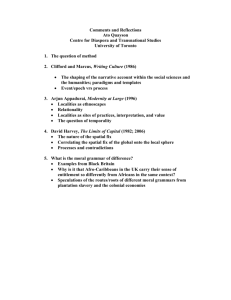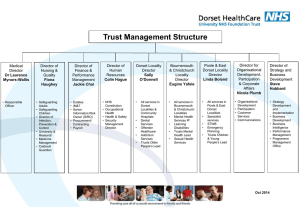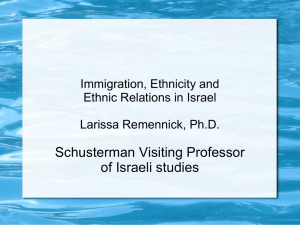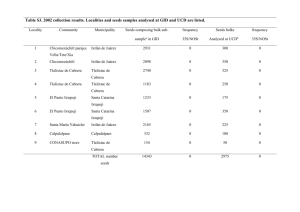Summary
advertisement
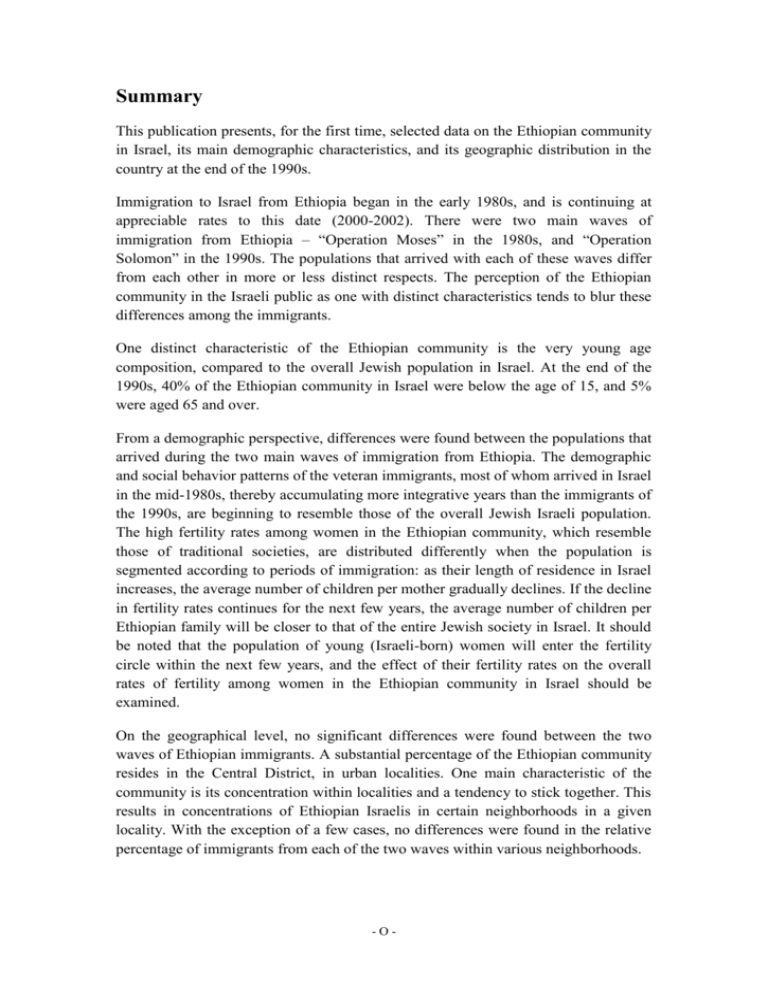
Summary This publication presents, for the first time, selected data on the Ethiopian community in Israel, its main demographic characteristics, and its geographic distribution in the country at the end of the 1990s. Immigration to Israel from Ethiopia began in the early 1980s, and is continuing at appreciable rates to this date (2000-2002). There were two main waves of immigration from Ethiopia – “Operation Moses” in the 1980s, and “Operation Solomon” in the 1990s. The populations that arrived with each of these waves differ from each other in more or less distinct respects. The perception of the Ethiopian community in the Israeli public as one with distinct characteristics tends to blur these differences among the immigrants. One distinct characteristic of the Ethiopian community is the very young age composition, compared to the overall Jewish population in Israel. At the end of the 1990s, 40% of the Ethiopian community in Israel were below the age of 15, and 5% were aged 65 and over. From a demographic perspective, differences were found between the populations that arrived during the two main waves of immigration from Ethiopia. The demographic and social behavior patterns of the veteran immigrants, most of whom arrived in Israel in the mid-1980s, thereby accumulating more integrative years than the immigrants of the 1990s, are beginning to resemble those of the overall Jewish Israeli population. The high fertility rates among women in the Ethiopian community, which resemble those of traditional societies, are distributed differently when the population is segmented according to periods of immigration: as their length of residence in Israel increases, the average number of children per mother gradually declines. If the decline in fertility rates continues for the next few years, the average number of children per Ethiopian family will be closer to that of the entire Jewish society in Israel. It should be noted that the population of young (Israeli-born) women will enter the fertility circle within the next few years, and the effect of their fertility rates on the overall rates of fertility among women in the Ethiopian community in Israel should be examined. On the geographical level, no significant differences were found between the two waves of Ethiopian immigrants. A substantial percentage of the Ethiopian community resides in the Central District, in urban localities. One main characteristic of the community is its concentration within localities and a tendency to stick together. This results in concentrations of Ethiopian Israelis in certain neighborhoods in a given locality. With the exception of a few cases, no differences were found in the relative percentage of immigrants from each of the two waves within various neighborhoods. -O- The low representation of Ethiopian immigrants in rural localities (which were the main type of settlement in their country of origin), can be attributed primarily to the Israeli government’s policy of trying to integrate them into relatively established urban localities, which would promote their integration into Israeli society. The Ethiopian population in rural localities (except for caravan sites) consists mainly of youth who reside in those areas temporarily while they are studying in various educational settings. Another issue examined in this publication is the mobility of new immigrants between the different localities in Israel – internal migration between localities. New immigrants are typified by high mobility rates during their first years in the country – and this was also true of the Ethiopian immigrants. However, those who arrived in the 1980s and had resided in the country for a longer period, changed their locality of residence less frequently than those who arrived later. By the end of 1999, the migration rates of the veteran Ethiopian immigrants resembled those of the overall Jewish population in Israel. At the end of 1999, the Central District was the preferred district of destination for the Ethiopian immigrants: those who arrived in the 1980s tended to move mainly to the Sharon Sub-district, whereas those who arrived in the 1990s moved to the Rehovot Sub-district. Positive migration rates were found in large urban localities (where most of the Ethiopian community resides), while negative migration rates were found in rural localities. This can be attributed largely to the departure of Ethiopian immigrants from temporary caravan sites, which were scattered throughout the country, and their settlement in permanent places of residence in various localities. A certain correlation was found between the immigrants’ first region of residence and their permanent region of residence. The veteran immigrants, who were taken as a group to the southern area upon their arrival in Israel, tended to move to urban localities in the Southern District (Be'er Sheva and Ashqelon), while those who arrived later and were mainly taken to the central area when they arrived tended to move to localities in the Central District (Rehovot and Netanya). The absorption of immigrants from Ethiopia in Israel is undoubtedly a long term process, since they have unique characteristics that distinguish them from the rest of the Jewish population in Israel. Most immigrants from Ethiopia start off in Israel at a low socioeconomic level. The majority of older members of that community lack primary education and are illiterate. Some of them have difficulty learning and using the Hebrew language, and are therefor limited in their ability to help the younger generation adjust to Israeli society. The coming years will have a strong impact on the absorption process of Ethiopian immigrants into Israeli society. It is possible that the assimilation in demographic and social patterns of many of the immigrants (e.g., the decline in fertility rates, and integration into the Israeli education system) will enable the younger generation to -P- obtain a broader education which will in turn offer them the opportunity of social and economic mobility. Definitions and Explanations Demographic Characteristics Age: a person's full years of age in the year of the registration of the address. Median age: the value for which half of the population is above and half of the population is below. Dependency ratio: the ratio between the number of persons aged 0-19 and those aged 65+, divided by the number of residents at the age of work (an indicator of the ratio between the dependent residents and the earners). Females males ratio: the ratio between the number of males divided to 1,000 females at the same age group. Marital status: refers to the legal personal status of inhabitants and is defined according to their declaration. Immigrant: a person entering the country to take up permanent residence under the Law of Return or the Law of Entrance. Country of birth: is defined according to the borders at the time of the estimate. Country of origin: for those born in Israel – father's country of birth; for those born abroad – country of birth. Geographical Divisions District and sub-district: districts and sub-districts are defined according to the official administrative division of the State of Israel. Type of locality: localities are divided into two principal groups: urban localities and rural localities; the distinction between them is based on size: Urban localities number 2,000 residents and more, and are classified by size. Rural localities number less than 2,000 residents and are classified by type as follows: Moshav is a rural locality organized as a cooperative, with rights to agricultural land (according to the terms of the Israel Lands Administration). This is a locality of family units, each of which functioning as an independent economic entity. Some of the production and economic administration belongs to the cooperative. The extent of cooperation is determined by the residents. Collective moshav is a rural collective locality where production and marketing are collective and consumption is private. Kibbutz is a rural locality where production and consumption are collective. Institutional locality is an institution which has the characteristics of a locality and is not included in the administrative boundaries of another locality. Communal locality is a rural locality organized as a cooperative society where the areas of cooperation (production, consumption, municipal -Q- administration, social activities) and their extent are determined by the residents. Other rural locality is a locality numbering less than 2,000 residents and which is not included under one of the types of rural localities specified above. Living outside localities: people scattered in small groups and living outside the boundaries of any locality. The places where such people live do not have the characteristics of a locality. Since the 1983 Census, the population of those “living outside localities” includes the bedouin tribes. Statistical area: a unit of area derived from a statistical-geographical distribution of urban localities numbering 10,000 residents and over. Internal Migration Measured according to the changes of address notified by residents and recorded in the Population Register. Non-reported changes to the Ministry of the Interior were not included. Migration between localities: reported change of address from one locality in Israel to another. Does not include first place of settlement of new immigrants upon arrival to Israel, as recorded in the Population Register . Persons entered (migration between localities): residents who report a move to one locality in Israel from another one, with the change being recorded at the Ministry of the Interior. Persons left (migration between localities): residents who report a move from one locality in Israel to another, with the change being recorded at the Ministry of the Interior. Migration balance: the difference between the number of residents who entered a locality and those who left it, in a defined geographical unit. -R-

